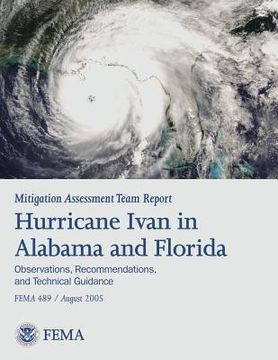Mitigation Assessment Team Report: Hurricane Ivan in Alabama and Florida - Observations, Recommendations, and Technical Guidance (FEMA 489) (in English)
Synopsis "Mitigation Assessment Team Report: Hurricane Ivan in Alabama and Florida - Observations, Recommendations, and Technical Guidance (FEMA 489) (in English)"
Hurricane Ivan made landfall on Thursday, September 16, 2004, just west of Gulf Shores, Alabama. The hurricane brought sustained wind speeds, torrential rains, coastal storm surge flooding, and large and battering waves along the western Florida Panhandle and Alabama coastline. After landfall, Hurricane Ivan gradually weakened over the next week, moving northeastward over the Southeastern United States and eventually emerging off the Delmarva Peninsula as an extratropical low on September 19, 2004. On September 18, 2005, the Federal Emergency Management Agency's (FEMA's) Mitigation Division deployed a Mitigation Assessment Team (MAT) to Alabama and Florida to evaluate building performance during Hurricane Ivan and the adequacy of current building codes, other construction requirements, and building practices and materials. This report presents the MAT's observations, conclusions, and recommendations as a result of those field investigations. Several maps in Chapter 1 illustrate the path of the storm, the depth of storm surge along the path, and the wind field estimates. Hurricane Ivan approximated a design flood event on the barrier islands and exceeded design flood conditions in sound and back bay areas. This provided a good opportunity to assess the adequacy of National Flood Insurance Program (NFIP) floodplain management requirements as well as current construction practices in resisting storm surge and wave damage. FEMA was particularly interested in evaluating damages to buildings in coastal A Zones where V-Zone construction methods are not required. The recommendations in this report are based solely on the observations and conclusions of the MAT, and are intended to assist the State of Alabama, the State of Florida, local communities, businesses, and individuals in the reconstruction process and to help reduce damage and impact from future natural events similar to Hurricane Ivan. The report and recommendations also will help FEMA assess the adequacy of its flood hazard mapping and floodplain management requirements and determine whether changes are needed or additional guidance required. The general recommendations are presented in Sections 8.1 and 8.2. They relate to policies and education/outreach that are needed to ensure that designers, contractors, and building officials understand the requirements for disaster-resistant construction in hurricane-prone regions. Proposed changes to codes and standards are presented in Section 8.3. Specific recommendations for improving the performance of the building structural system and envelope, and the protection of critical and essential facilities (to prevent loss of function) are provided in Chapter 8. Implementing these specific recommendations, in combination with the general recommendations of Section 8.1 and 8.2 and the code and standard recommendations of Section 8.3, will significantly improve the ability of buildings to resist damage from hurricanes. Recommendations specific to structural issues, building envelope issues, critical and essential facilities, and education and outreach have also been provided. As the people of Alabama and Florida rebuild their lives, homes, and businesses, there are a number of ways they can minimize the effects of future hurricanes.

